So, You Think You Love Horses?
Some Reflections on the Nature of Horses and Man
Glossary of Equestrian Terms
Words Beginning with B
-
Babble
[Fox Chasing] A fox hound is said to babble (be a blabber) when he frequently gives tongue on a scent other than a fox, one too faint to follow or nonexistent line out of excitement.
-
Baby Pad
[Equine Equipage] A baby pad is an thin, easily wastable pad designed to be a cover for the primary saddle pad. Saddle pads tend to acquire a build up of dirt, horse hair and dried sweet that is a challenge for residential washing machines and, in addition, pads take forever to dry. I would scour ours down under a jet of water, using a heavy plastic curry comb and dry them in the sun or my wife would sneak into the laundromat and put them into a commercial washing machine and dryer. Using a baby pad might have been the answer, but I did not know they existed.
-
Back Cinch (Flank Cinch)
[Equine Equipage] A back cinch is the second and rearward, optional girth of a western saddle. They are used for added security during particularly strenuous activities, in which the saddle might shift, such as hilly trail riding, cattle roping, reining or speed events. I have noticed some back cinches (also rear cinchas) hanging in reserve, very loose under the horses belly. Riders should be cautious about this kind of thing because a horse scratching its belly may become entangled in one. Many western riders maintain they only rarely would use one.
-
Backstretch
[Horse Racing] The backstretch is one of the four sections of an oval race track and is the one that is a straightaway farthermost from the viewing stand. The term is also used for the area in which horses are stabled adjacent to the racetrack and also part of the term "backstretch family," referring to the people working at the track.
-
Bag Fox
[Fox Hunting] A bag fox was one that had been caught in a trap, sold to a hunt and released as the object of the hunt. This practice is universally condemned today and is mentioned for historical reasons only. A bag fox is unfamiliar with the area that it is released in and unlikely to evade the hounds.
-
Balding Girth
[Equine Equipage] A Balding girth is a type of anti-chafe girth to prevent chafing of the skin and formation of galls. These are formed just behind the elbow of the horse in the girth area from rubbing of a girth on sensitive skin or trapped skin folds. Various measures can be undertaken to prevent theses and several different girth designs try to avoid pressure on the elbow area.
-
Balearic Horse
[Equine Breed] The Balearic breed is native to the Spanish Balearic Islands, the principal one being the island of Mallorca. They have a delicate head, a Roman nose, an arched neck with a thick, upright mane.
-
Balling (Ice Balls)
[Horse Management] When snow is on the ground, it can form into balls on the bottom of the hoof, making it difficult to walk for the horse. This can happen with bare foot horses but in my experience it is mostly something that commonly happens in shod horses. The warmth of the hoof and the cold of the horse shoe causes the snow to be trapped and refreeze forming a ball that grows with every step the horse takes. Before you ride it is easy enough to pick it out with a hoof pick. There are anti-snowball pads that a farrier can place on the bottoms of the hooves to help.
-
Ballotade
[Classical Dressage] The ballotade is a forward leap performed by a horse in which fore and hind legs are gathered under the body and and then lands on all legs. It is similar to a capriole, but the hind legs do not kick out. This is not done in ordinary dressage but is among the demonstrations by groups like the Spanish Riding School as one of the airs above the ground.
-
Banging a Horse's Tail
[Horse Grooming] Banging a horse's tail is to the practice of trimming the tail hairs even the bottom, those doing it believe that it creates a neater appearance and prevents split ends.
-
Bank Barn
[Horse Management] A bank barn is a type of multistoried barn that is built on a slope. The lower level is devoted to stalls and other areas devoted to horse care. These may include areas such as a feed room, track room, equipment storage, etc. The next upper level is generally reached by large doors on the opposite side of the building and up the bank. This area is used for hay storage. Lastly, there is a loft that might also be used for additional hay storage. There are many advantages to a bank barn. The stalls tend to be cooler in the summer and warmer in the winter. The drainage is downhill and good. The disadvantages are that there must be a building site on a slope and construction requires excavation. The loft is not easily reached since it does not open on ground level.
-
Barding
[Military Horse Equipage] Barding is armor used to protect horses in medieval times, both in war and in tournaments. Each part had a specific name and might be used in full or in part, depending on the situation. Barding was made from leather, mail, or plate armor and added a lot of weight. Leg were unprotected.
-
Barn Sour
Barn Sour
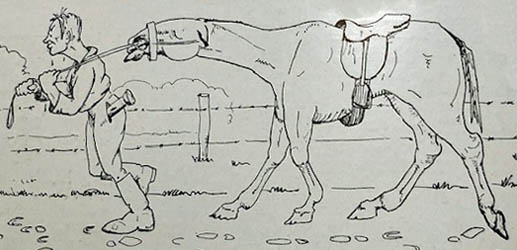
|
[Equine Behavior Problem] A barn sour horse misbehaves when asked to leave the stable area.
-
Bareback Pad
[Equine Equipage] A bareback pad is a special pad designed to be place on a horse's back, when riding without an actual saddle. It appears similar to a saddle pad but has a built-in girth strap. It offers a little extra padding for both parties and is a compromise between riding with a saddle or fully bareback. They may have cloth loops that can act like stirrups but do not get tangled in them and the girth can more easily slip around the horse's body than that of a true saddle.
-
Bareback Riding
[Equestrian Technique] A rider riding a horse bareback is not using a saddle but is mounted directly on a horses back. There are many disadvantages to doing this, which is why you see most riders in a saddle. It is a different feeling, being in direct contact with the muscles of the horses body, and working to maintain your own balance without the aid of the saddle and stirrups. A rider must have adequate experience before doing this and it is best if the horse has been introduced gradually to it as well. I have know people who impulsively hopped up on their horses back only to spend the rest of the day in an ER getting their fractures treated. I found on my horse bareback that I was very aware of being "sawed in half" by a prominent equine backbone. Bareback riding is equally taxing on a horse's back. I would suggest that It should be limited to short sessions for training purposes or done when swimming with your horse.
-
Barefoot
[Horse Management] A barefoot horse is a horse that is unshod, either on a temporary or permanent basis. Horses in their natural environment have done fine without shoes for millennia. However, humans typically do not ride horses on natural surfaces. Horse shoes have been used since ancient times and the Romans shod their horses, which were often ridden on paved roads or other hard surfaces. In more recent times most horses in urban environments were shod and the practice of leaving a working horse unshod became uncommon. In even more recent times what is called the "barefoot movement" has developed and advocates maintaining most horses barefoot. This is a judgement call and is influenced by the surfaces on which you ride and the natural toughness of an individual horse's hooves, which can vary. We ride on relatively soft surfaces and have barefoot horses but I notice in hot, dry weather they can be a little gimpy at the end of a long ride. To a degree the hoof will toughen with exposure. There are also various temporary hoof covers that can serve like shoes. Many people maintain horses shod on the forelegs but unshod on the rear. Barefoot horses usually require an occasional trim by a farrier.
-
Barrel
[Equine Anatomy] The barrel is the central part of a horse body between the shoulders and the flanks. A typical saddle covers the barrel and most of the barrel area conforms with the horse's rib cage.
-
Bars of the Bit
Mouthpiece of a Civil War Bit
showing port and bars of bit

|
[Equine Equipage] The bars of a bit are a part of the mouthpiece distinct from any port or joint the mouthpiece may have. The bars of the bit rest on the bars of the month when the bit is in place.
-
Bars of the Mouth
[Equine Anatomy] The bars of a horse's mouth are the toothless interdental spaces between the incisors and premolars on either side of the lower jaw where the bit is placed. The action of the bit will put pressure on the nerve rich soft tissue of the bars.
-
Barrel Racing
[Equestrian Sport] Barrel racing is a competitive rodeo event during which a horse and rider run a cloverleaf pattern around water barrels with the fastest time winning. In rodeos the event is limited to female riders. It requires a fast, responsive and maneuverable horse and a rider skilled at balance and timing.
-
Bars of the Gums
[Equine Anatomy] The bars are the toothless area of gums located between the incisor and molar teeth in a horse's mouth. The bit rests in the area.
-
Bars of the Hoof
[Equine Anatomy] The bars are two ridges of hoof material on the sole that run partway along the edges of the frog and support the frog. They are trimmed when a farrier works on the hoof.
-
Bat
[Equine Equipage] A bat is a type of short crop with a wide tab end.
-
Bean
[Veterinary Medicine] A bean is a waxy, gray lump of smegma that forms in the folds of the sheath (foreskin) of a male horse. It can enlarge to the point that its pressure impedes urination and must it be removed. During veterinary visits I request my veterinarian check for one.
-
Bearing Rein (Neck Rein)
[Basic Horsemanship] A bearing rein aid is executed by moving the rein against the neck on the side opposite the direction to turn rather than pulling on the bit. This maneuver is useful for one-handed riding and a particular feature of western riding. A rider using the bearing rein can use the same hand to turn the horse just by laying the rein on the correct side. It is one of the five basic rein aides.
-
Beat
[Equine Locomotion]
the number of footfall heard at a given gait. A walk is a four-beat. A trot is a two-beat and a canter is a three-beat.
-
Bedded Down
[Equine Management] A horse is said to be bedded down when all its care has been completed for the night.
-
Bedding
[Stable Management] Bedding is an absorbent material spread on the floor of a stall or horse trailer to provide cushioning. Materials such as wood shaving or straw are used. They need to be replaced periodically.
-
Beetewk Draught Horse
[Equine Breed] Beetewks are a Russian breed claimed to have been created on the instructions of Peter, the Great from imported Dutch draughts.
-
Behind the Bit
[Basic Riding] A rider always wishes to be what is called "on the bit." This is maintaining proper contact pressure with the reins and bit so as to effectively use the bit as an aid in communicating the rider's intentions to the horse. When a horse gets behind the bit it has lowered his head and has broken this contact. The rider then has lost any leverage on the horse's mouth. This often happens naturally when a horse is extending during a canter or it might be willful misbehavior on the part of the horse. When a horse gets behind the bit during a canter you might experience a sudden acceleration and the challenge is to get the horse back on the bit without overreacting to it and maybe precipitating bucking. The opposite of being behind the bit is called being above the bit.
-
Belgian Draught Horse
[Equine Breed] The Belgian is a heavily built draft horse native to Belgian. Stallions can weigh as much as 2000 pounds, A roan coat color is predominate. A population of Belgians imported into the U.S. have been breed to accentuate different features, being taller and less heavily built and are known as American Belgians.
-
Bell Boot (Over Reach Boot by British Usage)
Bell Boots
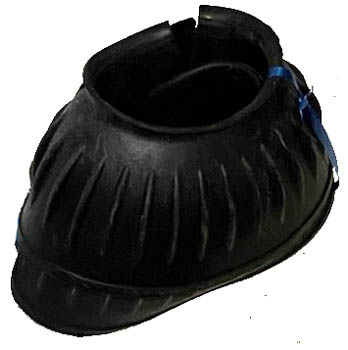
|
[Equine Equipage] A bell boot is a bell-shaped rubber boot with a central hole for the leg. They are designed to protect the bulbs of the heels from over-reaching injuries. Over-reaching is when the hind legs strike the back of the front hooves.
-
Bellmont Stakes
[Horse Racing] The Belmont Stakes race is the last one in the Triple Crown series run at Belmont Park in New York with a mile and a half distance.
-
Bend
[Equitation] A bend is when a rider creates a deliberate curve of the horses body during a turn..
-
Bezoar (Enterolith)
[Veterinary Medicine] A mass formed around a foreign body in the stomach or intestines that can cause colic, Surgery is often necessary. The foreign material might be hair, string, wadded plant material or even psyllium pellets, given to prevent prevent sand colic.
-
Billet Straps
[Saddle Terminology] Billet straps are straps under the flap of a saddle that hold the girth band in place. If not tight enough and partially with horses having a wide back the saddle can rotate, depositing the rider on the ground. I have seen this happen several times to others and provided no one is harmed it generally results in snickers from more veteran riders and maybe even the nearby horses. Always before mounting slide your fingers between the girth and the horse's body to check for proper tightness. You particularly should do this if someone else has tacked your horse for you. Too much girth tightness will result in the horse being uncomfortable. On an English saddle the billet straps have holes and the girth buckles in place.
-
Bit
[Equine Equipage] Bits are objects made of various materials but most often stainless steel that serve to exert pressure on the horse's month and cause the horse to stop or turn. They belong to the class of artificial aids and are divided into non-leverage and leverage types. The particular design of a given bit may cause it to act on one part of the mouth more so than another and to be milder or harsher and thereby more controlling. A given horse may do better with one style of bit versus another. Evidence of tooth ware from the use of a bit on equine skeletal remains is evidence of both domestication and the riding of horses. It suggests that the use of bits in horses' mouths was a truly ancient practice. An important lesson for the inexperienced rider is that bit pressure under usual circumstances should be very subtle and not a jerking movement.
-
Black Walnut Tree (Juglans nigra)
[Toxic Plant Material to Horse] Many people, including myself, use wood chips as horse bedding in stalls. However, those made from the wood of the Black Walnut trees should never be used. Ingestion of them may cause colic, edema or laminitis. These effects are mediated by a chemical compound called juglane.
-
Blank
[Fox Chasing] A covert (a likely or known fox hiding place) is said to be "blank" or the hunt to have "drawn a blank" when no fox is present. When a hunt finds no fox all day, the day is also said to be blank.
-
Blanket (Rug by British usage)
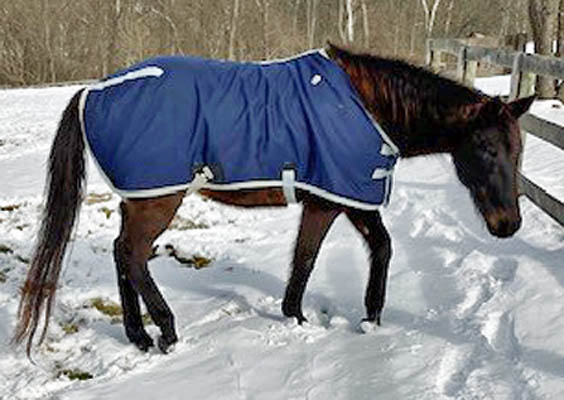
[Equine Equipage] You might think that a blanket is a superfluous for an animal who is covered by a coat of hair. However, there are many good reasons that domestic horses are blanketed by their owners. Domestic horse are kept in situations that they are not genetically adapted to live under. For example, a breed that developed in a warm climate is now exposed to wind chills in a cold climate. Similarly, horses that in nature would move to a nearby sheltered area, find themselves confined to a pasture exposed to the elements.
-
Blaze
[Coat Marking] A blaze is an extensive white making on a horse's face from the forehead down to the muzzle.
-
Blemish
[Showing] A blemish is a surface imperfection, generally resulting from an injury, that does not interfere with the horse's performance but that may count against it in certain types of showing.
-
Blinkers
[Equine Equipage] Blinkers are a type of head gear that are designed to limit the horse's vision to that which is in front of him and prevents things that are behind and to the side from being a distraction. For driving horses they project forward from the bridle and for race horses they are a fitted hood worn under the bridle, going over the ears and under the chin, exposing the eyes, but having a rim in the back that limits vision to the rear. The use of blinkers are optional, expect in most competitive events that do not allow them.
-
Blood Horse (Thoroughbred)
[Equine Breed]
Thoroughbreds were referred to as blood horses in recognition of their refinement and extensive pedigrees. They stood out in a world where most horses were utilitarian crossbreeds of unknown pedigree. I suspect the term is in use less frequently today when other pure bred breeds have attend the status once limited to the Thoroughbreds.
-
Blow
[Equine Vocalization]
A blow is a short, high-pitched sound that a horse makes to indicate that it is alarmed, excited or nervous. I often hear my gelding making it as an alarm call when I unexpectantly walk out of the wood near their pasture and he advances toward me, prior to the realization that its just me.
-
Blue Ribbon
Blue Ribbon
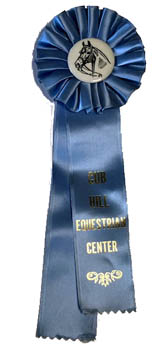
|
[Horse Showing] A blue ribbon is awarded at horse shows for a first place finish in the United States. In the United Kingdom first place is red and second place is blue.
-
Blowing Out
[Fox Chasing] Blowing Out is a long, sorrowful sounding wail from the hunting horn, repeated several times in a series, by the huntsman . It is used to gather and move the hounds to another location when no fox is found in the immediate area.
-
Bobtail
[Horse Grooming] Name given to a horse, whose tail has been docked or cut short. This is sometimes decorative, but also may have a practical goal, such as keeping mud or brambles out of the tail or to avoid it becoming tangled in hardness or caught in a Polo mallet. Current practice is just to fold the tail up and bandage in place. A horse's ability to fend off flies is impaired by permanent docking, which has fallen into disrepute.
-
Bobble
[Horse Racing] A bobble is a bad step away from the starting gate that causes the horse to lower his head or fall to his knees.
-
Body Brush
Vintage Body Brush

|
[Horse Grooming] A body brush is an oval, flat brush with fine short, closely set bristles that is used to finish grooming a horse. It removes smaller particles and imparts a sheen to the coat.
-
Boerperd (Dutch for Boer Horse)
[Equine Breed] Boerperds are native to South Africa and reach back in their development to refinements of the traditional Cape Horse or old-type Boer Horse. They are known for their stamina, sure-footedness and hardiness. They are sometime employed in riding safaris.
-
Bolt
Bolt
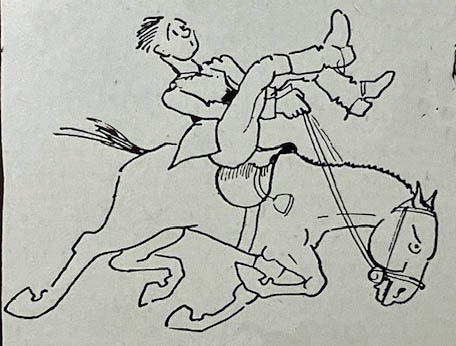
|
[Equine Behavior] A horse that becomes disturbed and suddenly runs off while being ridden or driven is said to bolt. The challenge to the rider is to hang on and bring the animal back under control. The behavior is dangerous for both the human and the horse. Often the horse ignores aids. Emergency dismounts might be done but themselves entail risks of injury. Turning the horse's head and body away from the direction of movement, including using pulley reins is an option. It is a particularly scary feeling the first time in happens to you and the realization hits you that you have no control over a galloping animal. However, fight down the tendency to panic. Horses are wonderfully intuitive animals and they sense our emotions better then you think. Your fear only reinforces their fear. Always remember if you have no control over yourself you cannot expect to have any control over the horse. Have faith that they will eventually stop.
-
Bolt Closure
Bolt
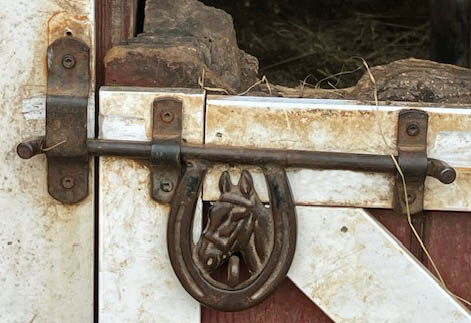
|
[Horse Management] A bolt closure is a common means to secure a stall door.
-
Bolting
[Equine Behavior] Other than a horse running off, bolting has a second meaning. A horse that too rapidly ingests its food is said to be bolting its food. This is not desirable in that it puts them at risk of choking. It often happens when a horse is worried about more dominate pasture mates chasing it away from its food. An owner should consider identifiable causes and try to remedy them.
-
Bone in the Ground
[Fox Chasing] The term bone in the ground describes a condition of the hunt field in which the ground is frozen beneath but has a soft surface layer. There is a danger of slipping and sliding.
-
Bone Spavin
[Veterinary Medicine] Bone spavin is a degenerative arthritic condition of the lower hock joint.
-
Boot Jack (Boot Puller)
Boot Jack
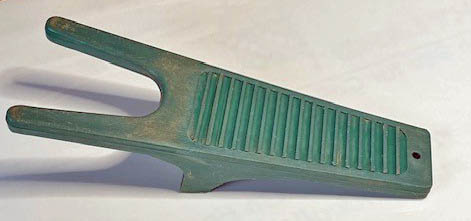
|
[Equipment] A boot jacker or boot puller is designed to help remove a pair of boots. It is possible to remove boots without one, but the puller makes it so much easier. I remember on one of our riding trips, the other riders initially encounter my wife and I struggling to remove my boots. It was not the most dignified introduction and did I mention we forgot to pack our boot jack.
-
Boot Strap Puller (Boot Hooks)
Pair of Boot Strap Pullers
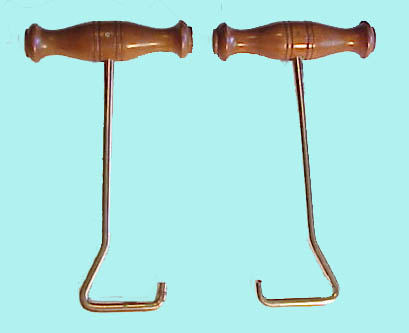
|
[Equipment] Traditional Leather Riding Boots are not so easy to get on. They came with a pair of boot strap pullers. The inside of the boots had pairs of leather loops in which the ends of the pullers passed. One then pulled the boots on by pulling against the handles of the boot pullers. This is a possible origin of the expression to "pull yourself up by your bootstraps." It the case of leather ridding boots it only seemed like it. I valve my boots with zippers personally.
-
Bosal
[Equine Equipage] A bosal is a length of braided rawhide that in a hackamore bitless bridle applies pressure to the horse's nose and chin. Bosals end in a heel knot that attach to the reins.
-
Bot Block
Bot Block

|
[Horse Management] A bot block is a specialized grooming tool solely designed to remove bot eggs from a horse's coat. It is is a porous fiberglass block that is rubbed on the involved area and catches the eggs in its rough surface. It works very well over a wider area than the bot knife (see below). I tend to use either tool or both depending on the surface contour and the number of eggs.
-
Bot Knife
Bot Knife

|
[Horse Management] A bot knife is a specialized grooming tool solely designed to remove bot eggs from a horse's coat. There are small teeth along one edge that catches the eggs and pulls them off the hair. It works very well.
-
Botfly
Bot Fly, Bot Larvae and Eggs on Horse
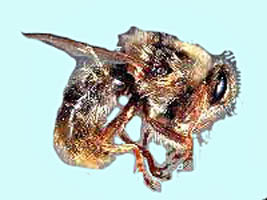
|
| 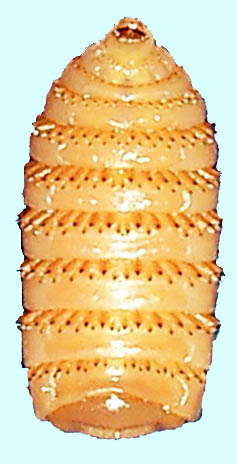
|
| 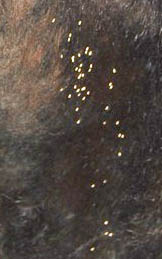
|
[Veterinary Medicine] One of several species of flies, which lay eggs on horses. The small, yellow, sticky, oval eggs are found attached to the horse's hair, commonly on the legs and shoulders. They are easy to spot while doing routine grooming. They can be removed with a special bot knife or rubbing the area with a bot block (groom stone), which is a porous fiberglass block. The presence of eggs causes itching and the horse to lick the area. If the eggs are not removed they hatch, and the larvae (bots) are ingested by the horse, becoming internal parasites.
-
Botulism
[Veterinary Medicine] Botulism is a form of poisoning caused by a toxin, produced by the anaerobic bacterium Clostridium botulinum. The condition fortunately is very rare in horses and generally occurs when a horse consumes hay that has been contaminated by a dead small animal carcass. The symptoms are a progressive motor paralysis, including respiratory and cardiac muscles. The mortality rate of horses that arrive at a veterinary hospital is about 50%. Treatment includes an antitoxin and several other medications plus supportive care.
-
Box (British Usage])
[Equine Transportation] A horse box corresponds to the American term horse trailer. A conveyance to transport horses on road.
-
Bowed Tendon
[Veterinary Medicine] A bowed tendon is a degenerative condition of the front leg's flexor tendon sheath, caused by repeated strain. The condition will improve with rest and anti-inflammatory medication.
-
Bowl-in
[Polo] A bowl-in happens when the umpire starts or resumes play by rolling the ball down the center of a line up of the players
-
Box Stall
[Equine Housing] A box stall is a square or rectangular area within a barn or stables set aside for the use of a horse. Its function is to shelter the horse from the elements, allow a horse to be fed without interference from aggressive pasture mates, have a quiet space for folding, confine a horse that is interfering with procedures being carried out on stablemates, etc. In some situations horses are confined in their stall for long periods of time. Common rationalizations for doing this is to prevent injuries in the field, not having to retrieve the horse from a large pasture, keep them cleaner, etc. For the most part our practice has long been to leave the door open to the field and let the horse decide if it wishes to be in or out.
-
Brace
[Polo] A brace is the horse's stance from which the stroke is taken.
-
Braiding a Horse's Mane
Braiding
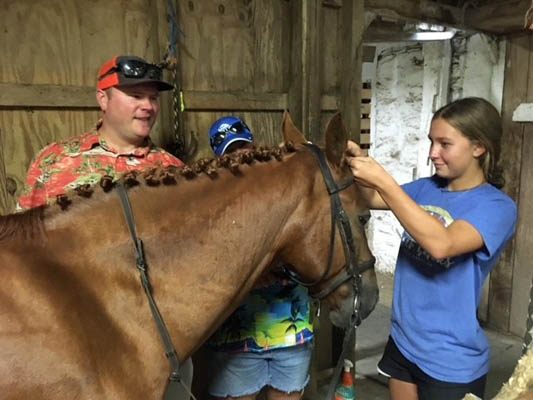
|
[Horse Care] Horse's manes are often braided in preparation for a show or hunt. There are several styles of braiding and several techniques for performing it.
-
Bran Mash
[Horse Management] A bran mash is made from wheat bran mixed in warm water and fed to a sick horse. Although my wife often threatened to made some up for our horses, I cannot remember her ever really doing it. Since modern research suggests limited benefits, it appears that the enthusiasm for using it has mostly passed.
-
Breakover
[Equine Gait] The point in the horse's stride at which the final toe in the series is lifted off of the ground,
-
Break Stride
[Equine Gait] A horse breaks stride when it goes from one gait into another.
-
Breaking a Horse
[Equine Training] Breaking is a traditional term for the initial training of a young, totally inexperienced horse. In prior times methods were extremely harsh and there was a sense that any spirit of resistance should be totally broken. To do otherwise was undesirable and making a spoiled pet of an animal. Child rearing practices were not much better in those times either. I am happy to say that attitudes have changed and modern horsemen totally avoid any harsh means in training. I discovered that if a young animal trusts you, the process is rather bland and the horse reacts more with confusion regarding your intentions rather than any great resistance. The first time I climbed into the saddle, my young horse did not buck as I feared he would, having watched too many cowboy movies and he seemed more puzzled by the whole thing. Additional terms indicate the stage of training; for example, halter broke indicates a young horse that willingly accepts having a halter placed on its head but has not yet advanced beyond that. To escape the harsh connotations of the term breaking, modern training of a green horse is often called starting.
-
Breaking Tackle
[Equine Equipage] Breaking tackle is an obsolete term for the various special tack used in the indicial training of a green horse. Many of these items might also be used for continued training. I suspect we might now call them "starting tackle."
-
Breastcollar (Breastplate)
A 3-Point Breastcollar
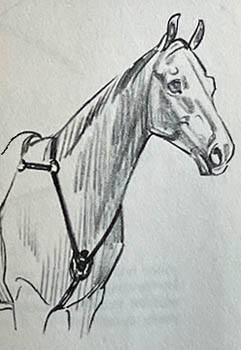
|
[Equine Equipage] A breastcollar is an optional piece of tack that keeps the saddle from sliding backwards on the horse. There are 3-point and 5-point breastcollars available. The 3-point has a central piece resting mid-chest with three straps running off of it. The lower one passing between the horses legs and has a loop that the girth passes through. The other two on either side run upwards and attach to the front of the saddle via small clips and d-rings build into the saddle. Those are fitted with a bridge strap that passes over the neck and joins the two side pieces. The 5-point add an additional pair that run backway on either side and attach by loops to the upper part of the girth. A martingale can be added. Do not forget that this rig is no substitute for a properly fitted sable and properly tightened girth. Breastcollars are also incorporated into certain types of harnesses.
-
Breastcollar Harness (Breast Strap)
[Driving Equipage] A breastcollar harness is a padded strap running across the front of the horse's chest in lieu of a full collar. It does not require fitting and is suitable for light loads. Heavy loads should be drawn with the horse having proper full horsecollar.
-
Breeching Strap
Pleasure Driving Harness with a Breeching Strap
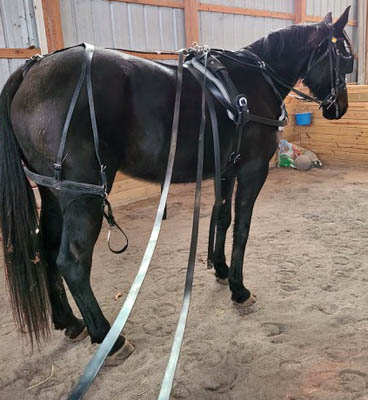
|
[Driving Equipage] A breeching strap is part of a harness that runs around the haunches of the horse to brake or stabilize a load when going downhill. It is required with a heavy harness rig and provides more support than a simple crupper strap.
-
Breeder's Cup
[Horse Racing] The Breeders Cup is an annual, year-end Thoroughbred race run at different tracts each year for million dollar purses. There are various categories of horses competing over different distances. There is also a Breeder's Cup steeplechase race held on another day and location
-
Breeds
[Horse Types] I use the term horse breed repeatedly and so do others yet if you google horse breeds you tend to get lists of breed names rather than a general discussion of just what the implications are of the term "breed" are. It is all a matter of population genetics. Historically, there was an ancient population of horses in their natural state. The gene pool contained so many genes governing various traits that allowed the animal to adapt to its environment. Nature tends to select genes that allow animals to survive predation, exploit potential food sources, and surmount environment challenges, etc. Horses are fast runners because those that were not were taken by predators. Horses survive because they are adapted to eat grass, something that humans cannot do. Certain horse breeds survive in cold, harsh climates because they have a second insulating winter coat. The ancient horse in its natural state is nothing like our modern horse breeds. What we see today as breeds are totally the work of man with domesticated animals and the product of our selected breeding. Humans did this often simply for the novelty or for the aesthetics of a given feature. Since horses can have multiple generations within the lifetime of a given human breeder it is possible to bring out a trait that the breeder desires as a feature within a restricted breeding herd. For example, the native color of ancient horses was dun but if you have one that has a slightly different coat color you can restrict that individual's ability to mix its genes in the general population and in time develop a herd with a different color. We tend to take pride in saying our animal is "pure bred." However, this is not all for the population's good. By restricting a breeding population of any animal, even humans, we are placing that population at risk of not having a healthy decree of genetic diversity. There are many examples of genetic diseases commonly found in both equine and human populations that tend towards being inbred.
-
Breeze
[Horse Racing] Race horses being briskly exercised for conditioning outside of actual racing are being breezed.
-
Bridoon
[Equine Equipage] A bridoon is a narrow snaffle bit used with a double bridle and combined with a curb (Weymouth) bit. The two bits and the bridle in combination is called a Weymouth bridle.
-
Bridle Path
[Horse Management] A bridle path is an area of shaved mane behind the pole, corresponding to the point that the bridle rests on the neck. It is done to allow a halter or bridle to rest on a flatter surface.
Bridle Path
[Trail Riding] A bridle path is a riding trail created for horses, often at a public park. Many are multiuse with other kinds of recreational activity allowed. They must be maintained with adequate head clearance for riders and adequate side clearance for users to pass each other. Local riding clues often support their local venues with trail maintenance days and advocacy support. The later is important in that some resource managers seem to believe parks should be left in their natural state and allowing trail maintenance and riders is too disruptive. It is also important in that local governments generally lack the funding to adequately maintain trails.
-
Broncho (Bronc for short)
[Rodeo Riding] A broncho or bucking broncho is a horse used in rodeo saddle or bareback events. The term was used earlier used in the American southwest for any unbroken feral horse. The word came from the Spanish adjective broncho, which means rough or rude.
-
Brougham
A Brougham
Courtesy Wikipedia and Pearson Scott Foresman
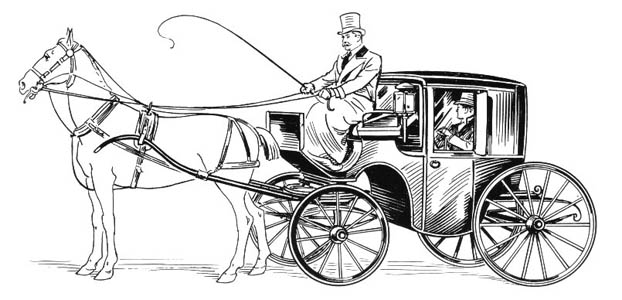
|
[Carriage Type] A Brougham was a 4-wheeled, box like, closed carriage, holding two to four people with the driver's perch outside.
-
Browband
[Horse Tack] The browband is the part of a bridle headstall that runs over the horse's forehead and attaches on either side to the cheekpieces.
-
Brumby (Australian Usage)
[Equine Type] A brumby is term for a free-roaming feral horse, used in Australia. Various sources seem to disagree whether or not brimbies constitute a precise breed or if the term simply means any feral horse.
-
Brush
[Fox Chasing] Term used in fox hunting for the tail of a fox. Often it is the first and the very last part you see.
-
Brush Fence
[Jumping] A brush fence is a jump constructed with brush like material on the top surface. It is made such that the horse can brush through (skim through) the brush in a flat jump, which is not considered a fault. Learning to jump a brush jump correctly is a challenge for both horse and rider.
-
Brushing
[Veterinary Medicine] Brushing is a form of gait interference, which is when the hoof of the foreleg hits the hindleg during some phase of a horse’s stride often resulting in minor injuries. The simplest remedy is to use ankle boots. However, the cause may be worthy of a veterinary visit if the horse has more serious injuries, is lame or seems to be in pain.
-
Bucking
Buck
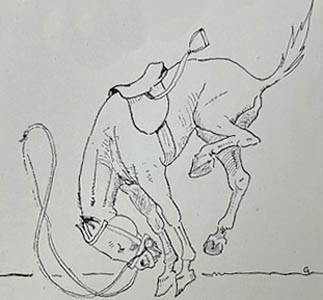
|
[Equine Behavior] Bucking is a normal behavior under certain circumstances. Some examples are when a horse is playful, excited, releasing pent up energy, being tormented by biting insects, defending against a predator or just wants an annoying rider off its back. To buck horses throw their heads downward, arch their backs and push up and kick out with their rear legs. It is possible in a group of horses for a kick to connect and injure another herd member. Under usual circumstances you do not want a horse to buck when under saddle. If you are alert to what is about to happen, it is possible to ride a buck out. Many bucks are half-hearted and place the rider at little risk. The secret is to keep your balance, stand slightly in the stirrups to allow some air space between your bottom and the horse's arching back and hold on tightly with your legs. If the horse's back gets under you, it is able to propel you up into the air with enough force to break you grip and cause the loss of your stirrups. Once that happens chances are the ground is next for you. Turning the horse to one side forcefully and riding in a circle interferes with bucking. Attempting to pull the head up with both reins common results in the rider doing a flip over the horse's head. They are the stronger ones after all. When a horse habitually bucks under saddle it cannot be ignored and a trainer should be working with you.
-
Bucking Rolls
[Western Saddle Accessory] Bucking rolls are a pair of removable oval padded pieces that are added to the front of a Western slick fork style saddle just behind the horn. They often are brightly colored to match other features of the saddle and have the appearance of a pair of headphones lying flat on the saddle. Their purpose is to add additional stability for the rider.
-
Bucking Strap
[Tack] A bucking strap is an optional, short leather strap attached across the pommel of an English saddle to provide an emergency handhold. I never bother with one, believing that a rider's balance is much more important.
-
Buckskin
[Horse Coat Color] A horse termed a buckskin has a yellowish or grayish tan coat color, similar to a buck deer. Buckskins appear similar to duns, but lack the duns' so-called primitive markings (wild type markings), such as a dorsal stripe.
-
Buggy
A Lancaster Buggy
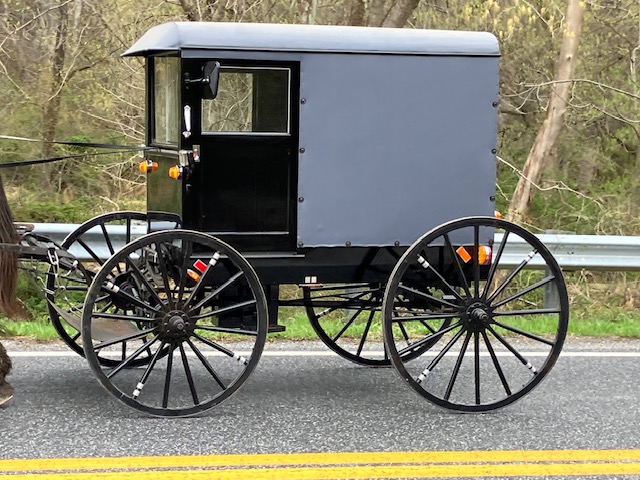
|
[Carriage Type] A buggy is a light, four-wheeled carriage with a single seat.
-
Buggy (British Usage
[Carriage Type] A buggy is a light, two-wheeled, gig-like vehicle with a single seat.
-
Bulb of the Heal
[Equine Anatomy] Heal bulbs are soft tissue at the very back of the hoof that covers the digital cushion. They are subject to over-reaching injuries in some horses.
Bulldogger
[Rodeo] In steer wrestling the bulldogger is the primary rider, who must grab the steer by the horns, slip out of the saddle and wrestle the steer to the ground.
-
Bulldogging (Steer Wrestling)
[Rodeo] bulldogging is rodeo event in which the primary rider grabs the steer by the horns, slip out of the saddle and wrestle the steer to the ground. He is assisted by a second rider, called the hazer, who must ride parallel to the steer and keep it running straight. Unlike many other rodeo events, bulldogging is not practiced on working ranches and the event was devised as a purely rodeo event.
-
Bumper Pull
[Horse Trailering] A bumper pull describes one of two major means of attaching a horse trailer to the tow vehicle. The tongue of the trailer is lowered into a metal ball on a hitch fitted into the back of the vehicle. The other major type is a goose neck.
-
Burning Scent
[Fox Chasing] A strong scent that the hounds follow without any hesitation.
-
Bute (short for Phenylbutazone)
[Veterinary Medicine] A nonsteroidal anti-inflammatory drug, commonly used in situations like lameness or other injuries. It can have side effect, such as causing peptic ulcers and should be used judiciously.
-
Buzkasi
[Horse Sport] Buzkasi is an ancient Afghan mounted sport in which teams compete to bring an animal carcass, picked up from the field or grabbed from an opponent across a goal line. During the Afghan War U.S. special forces soldiers played Buzkasi with Afghan allies. Traditional Buzkasi had no real rules of play and might have hundreds of participants over a vast field with the spectators also mounted and mixed with the participants. It was, in a word, as pure horse mayhem as anyone might enjoy. Afghan king Zaber Shab tried to organize the sport with a standard field and rules of play, but his tribesman had little use for them. The game is still played today.
-
By
[Equine Lineage] The term "by" is paired with "out of" to indicate a horse's parentage. For example, the legendary Native Dancer was by Polynesian out of Geisha.
-
Bye Day
[Fox Chasing] A bye day is an extra, unscheduled day of hunting.
Glossary of Equestrian Terms: Main Alphabetical Listing
Links to Other Sites with Equestrian Interests
Back to Introduction






















